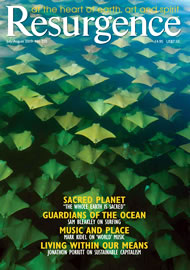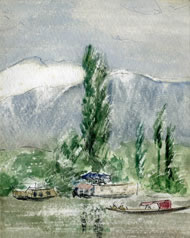JILL PAINE TWICE studied art in her life: the first time at Chelsea Art College in 1936 when she was twenty-six, and again in 1992 at the age of eighty-two in classes arranged by the East Anglian Chinese Brush Painters’ Society. But she was already painting by the age of ten and a self-portrait the following year shows the back view of a sturdy redheaded girl striding out along a path, swinging her stick.
That path led through a life in which Paine never ceased to sketch and paint, and it is these sketchbooks and portfolios that her daughter Mary retrieved after her death. On almost every page of this beautiful book there is a colour illustration of Jill’s work, interspersed with reflections and quotations from her diaries.
Paine’s path was not without adventure. Among the photographs there is one showing her in her WRNS uniform on her motorbike, lined up with six other intrepid Admiralty dispatch riders, young women negotiating the London streets during the Blitz. Before the war we find her walking in the Himalayas above the snow-line in Kashmir while staying with her brother Jack, who spent all his life as a teacher in India.
Mountains remained a delight into old age, when Paine spent many holidays in the Scottish Highlands. Yet she was content in her middle years to be happily married to a country priest, and to bring up three children in their Norfolk rectory with that rare parental wisdom of being always available and ready to share experiences, but not, as she said, “to interfere too much in my children’s lives!”
As a painter she reflected deeply on the relation of art and Nature. In her youngest days she had already discovered and learnt how the language of art makes sense and celebrates the natural world of creation, and human life within it. When she was twenty-three she wrote in her notebook, “That which constitutes the wonderful is something that gives everything a new and fuller and wider conception, something that throws new light on our conception of things... The beginning of wisdom is wonder.” And then at art college a little later, “To live fully our lives must have form, spiritual significance, and a job we enjoy doing.” And we find her echoing Constable in her own words, “We see nothing until we truly understand it. Man’s nature is congenial with the elements of the planet itself.”
“Art”, she notes, “has never been a copy of Nature,” (she is quoting the modern Dutch painter Piet Mondrian) “for such a copy would not have been strong enough to evoke human emotions. The living beauty of Nature cannot be copied: it can only be expressed.
For her that experience is shot through with her Christian faith. “As the spirit of the artist is in the work of art, so is the spirit of God in Nature,” she writes. So it is that Mary, in her introduction to this book, can write, “It is this vision that transforms Jill’s work into a celebration of life itself.” •
Victor de Waal is an Anglican priest and writer and teacher of theology.













